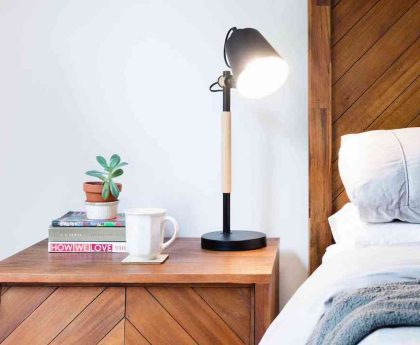Proper bedroom lighting is often overlooked when it comes to designing and decorating a bedroom. However, it plays a crucial role in creating a comfortable and inviting space. The right lighting can enhance the mood, improve sleep quality, and highlight the beauty of your bedroom decor. In this article, we will explore the importance of bedroom lighting and provide tips and ideas for creating the perfect lighting design for your bedroom.
Key Takeaways
- Proper bedroom lighting is important for creating a comfortable and functional space.
- Consider different types of lighting fixtures, such as overhead lights, table lamps, and wall sconces, to achieve the desired effect.
- Choose bulbs with the appropriate brightness and color temperature for your needs.
- Layering your bedroom lighting with different fixtures and dimmers can provide optimal illumination for different activities.
- Smart lighting and dimmers can help create a relaxing atmosphere and save energy.
Understanding the Importance of Proper Bedroom Lighting
The impact of lighting on mood and sleep cannot be overstated. Bright, harsh lighting can make a bedroom feel cold and unwelcoming, while soft, warm lighting can create a cozy and relaxing atmosphere. The type of lighting you choose can also affect your sleep quality. Bright, blue-toned light can disrupt your natural sleep-wake cycle, making it harder to fall asleep and stay asleep.
Good bedroom lighting has several benefits. It can help you wind down at the end of the day and prepare your body for sleep. It can also create a soothing ambiance that promotes relaxation and tranquility. Additionally, proper lighting can enhance the functionality of your bedroom by providing adequate illumination for reading, getting dressed, and other activities.
Types of Lighting Fixtures to Consider for Your Bedroom
When it comes to bedroom lighting, there are several types of fixtures to consider. Ceiling fixtures are a popular choice as they provide general illumination for the entire room. Table lamps are great for bedside lighting and can be easily adjusted to provide task lighting when needed. Floor lamps are versatile and can be used to create ambient or task lighting in different areas of the room. Wall sconces are a stylish option that can be used to highlight artwork or create a soft glow. Pendant lights are another option that can add visual interest and provide focused illumination.
Choosing the Right Bulbs for Your Bedroom Lighting
| Light Bulb Type | Wattage | Color Temperature | Dimmable | Energy Efficiency |
|---|---|---|---|---|
| LED | 9-12 watts | 2700-3000K | Yes | High |
| Halogen | 40-60 watts | 2800-3200K | Yes | Medium |
| Incandescent | 40-60 watts | 2700K | No | Low |
| CFL | 13-15 watts | 2700-3000K | Yes | High |
Choosing the right bulbs is essential for achieving the desired lighting effect in your bedroom. There are several types of bulbs to choose from, including incandescent, LED, and compact fluorescent bulbs. Each type has its own advantages and disadvantages. Incandescent bulbs produce a warm, soft light but are less energy-efficient. LED bulbs are energy-efficient and long-lasting, but can be more expensive upfront. Compact fluorescent bulbs are also energy-efficient but can take some time to reach full brightness.
When selecting bulbs for your bedroom lighting, consider the wattage and brightness. The wattage indicates the amount of power the bulb consumes, while the brightness refers to the amount of light it produces. For general lighting, aim for a total wattage of around 60-75 watts. For task lighting, such as reading or applying makeup, opt for bulbs with higher brightness levels.
Color temperature is another important factor to consider when choosing bulbs for your bedroom lighting. Color temperature is measured in Kelvin (K) and refers to the warmth or coolness of the light emitted by the bulb. Bulbs with a lower color temperature (around 2700K-3000K) produce a warm, yellowish light that is ideal for creating a cozy atmosphere in the bedroom. Bulbs with a higher color temperature (around 4000K-5000K) produce a cool, bluish light that is more energizing and suitable for task lighting.
Layering Your Bedroom Lighting for Optimal Illumination
Layering your bedroom lighting involves using different types of fixtures and bulbs to create a balanced and visually appealing lighting design. The concept of layering involves three main layers: ambient lighting, task lighting, and accent lighting.
Ambient lighting provides overall illumination for the room and sets the mood. This can be achieved through ceiling fixtures or a combination of ceiling fixtures and wall sconces. Task lighting is focused illumination that is used for specific activities such as reading or getting dressed. This can be achieved through table lamps, floor lamps, or pendant lights. Accent lighting is used to highlight artwork, decor, or architectural features in the room. This can be achieved through spotlights, wall sconces, or even string lights.
To create a well-layered lighting design in your bedroom, start by determining the main activities that will take place in the room and the areas that need to be illuminated. Then, choose the appropriate fixtures and bulbs for each layer. For example, you may use a ceiling fixture for ambient lighting, a table lamp for task lighting, and wall sconces for accent lighting.
Creating a Relaxing Atmosphere with Dimmers and Smart Lighting

Dimmers and smart lighting can greatly enhance the ambiance of your bedroom and allow you to adjust the lighting to suit your needs and preferences. Dimmers allow you to control the brightness of your lights, allowing you to create a soft and relaxing atmosphere in the evening and a brighter, more energizing environment during the day. Smart lighting systems take it a step further by allowing you to control your lights remotely through a smartphone app or voice commands.
To incorporate dimmers into your bedroom lighting design, consider installing them for your ceiling fixtures or using table lamps with built-in dimmer switches. For smart lighting, you can invest in smart bulbs that can be controlled through an app or purchase a smart lighting system that allows you to control multiple lights and create custom lighting scenes.
The Impact of Color Temperature on Bedroom Lighting
Color temperature plays a significant role in setting the mood and atmosphere of your bedroom. Warm light with a lower color temperature (around 2700K-3000K) creates a cozy and inviting ambiance that is perfect for winding down at the end of the day. Cool light with a higher color temperature (around 4000K-5000K) is more energizing and suitable for task lighting.
When choosing bulbs for your bedroom, consider the color temperature that best suits your needs and preferences. You may opt for warm light for general lighting and cool light for task lighting. Alternatively, you can use bulbs with adjustable color temperature or smart bulbs that allow you to change the color temperature according to your mood and activities.
Maximizing Natural Light in Your Bedroom
Natural light is a valuable asset in any bedroom as it provides a sense of connection to the outdoors and can make the space feel more open and airy. To make the most of natural light in your bedroom, consider the placement of windows and the orientation of your room. South-facing windows tend to receive the most sunlight throughout the day, while north-facing windows receive indirect light. East-facing windows provide morning sunlight, while west-facing windows provide afternoon sunlight.
To enhance natural light in your bedroom, keep window treatments minimal or opt for sheer curtains that allow light to pass through. Avoid blocking windows with furniture or other objects that may obstruct the flow of light. You can also use mirrors strategically to reflect natural light and make the room appear brighter and more spacious.
Highlighting Artwork and Décor with Accent Lighting
Accent lighting is a great way to highlight artwork, decor, or architectural features in your bedroom. It adds visual interest and draws attention to specific areas or objects in the room. To use accent lighting effectively, consider the placement of your artwork or decor and choose fixtures that can be easily adjusted or directed towards the desired focal point.
Spotlights are a popular choice for accent lighting as they provide focused illumination. Wall sconces can also be used to highlight artwork or create a soft glow on the walls. String lights are a whimsical option that can be draped around a mirror or used to create a cozy atmosphere.
Considerations for Small Bedrooms and Unique Layouts
Designing bedroom lighting in small spaces or rooms with unique layouts can be challenging, but with some creativity, it can be done effectively. In small bedrooms, consider using wall-mounted fixtures or pendant lights to save space on bedside tables or floor space. Utilize mirrors strategically to reflect light and make the room appear larger. For rooms with unique layouts, such as sloped ceilings or alcoves, consider using adjustable fixtures that can be directed towards the desired area.
Tips for Creating a Cozy and Inviting Bedroom with Lighting Design
To create a warm and inviting bedroom with lighting design, consider the following tips:
1. Use warm light with a lower color temperature for a cozy ambiance.
2. Incorporate dimmers or smart lighting to adjust the brightness according to your needs.
3. Layer your lighting with a combination of ambient, task, and accent lighting.
4. Highlight artwork and decor with accent lighting to add visual interest.
5. Maximize natural light by keeping window treatments minimal and using mirrors strategically.
By implementing these tips, you can transform your bedroom into a cozy and inviting sanctuary.
In conclusion, proper bedroom lighting is essential for creating a comfortable and inviting space. It can enhance the mood, improve sleep quality, and highlight the beauty of your bedroom decor. By understanding the importance of proper bedroom lighting and considering factors such as types of fixtures, bulbs, layering, dimmers, color temperature, natural light, accent lighting, and unique layouts, you can create a cozy and inviting bedroom that meets your needs and preferences. So go ahead and implement these tips and ideas to create the perfect lighting design for your bedroom. Sweet dreams!



